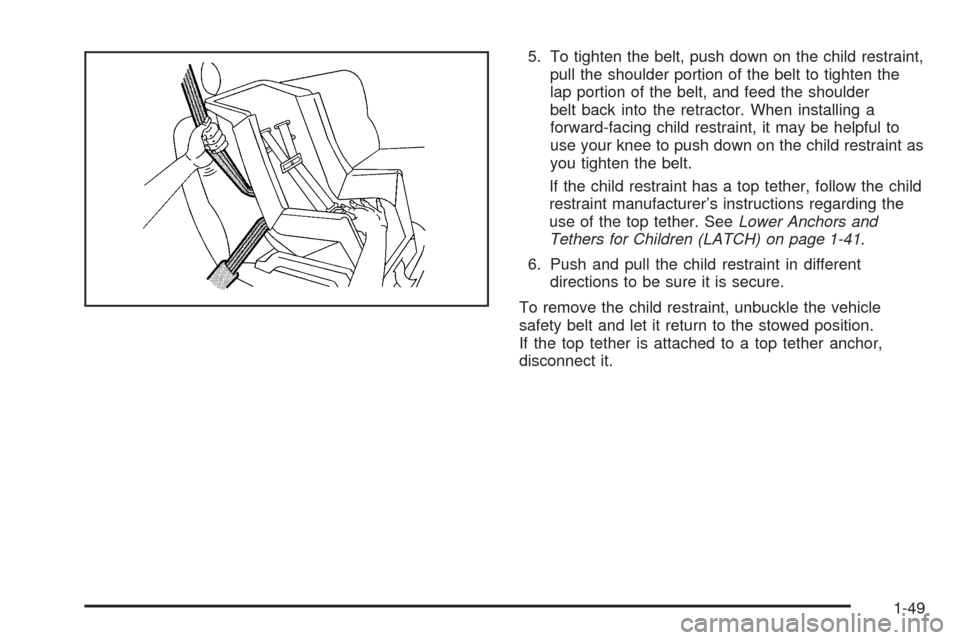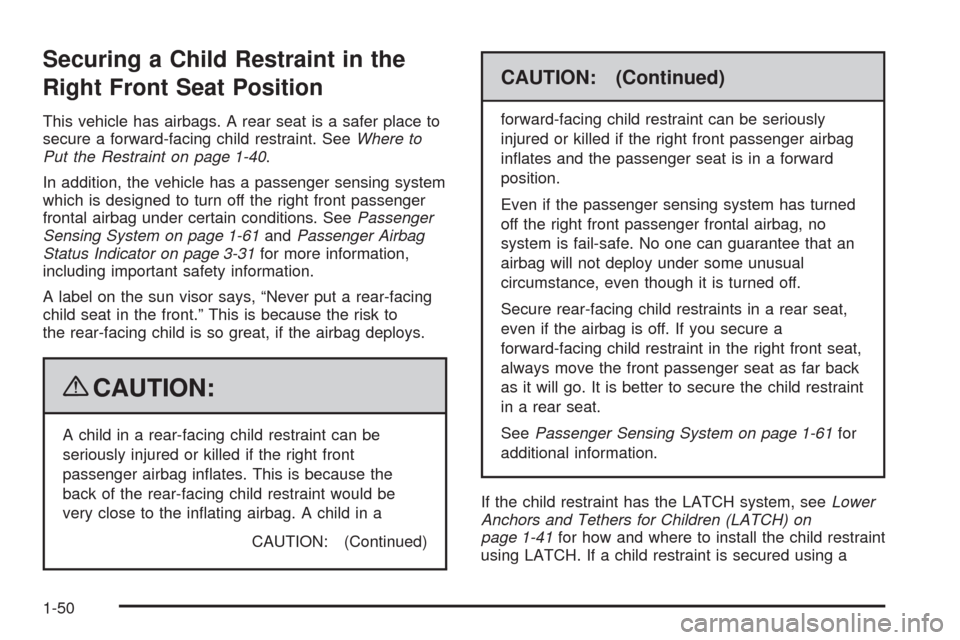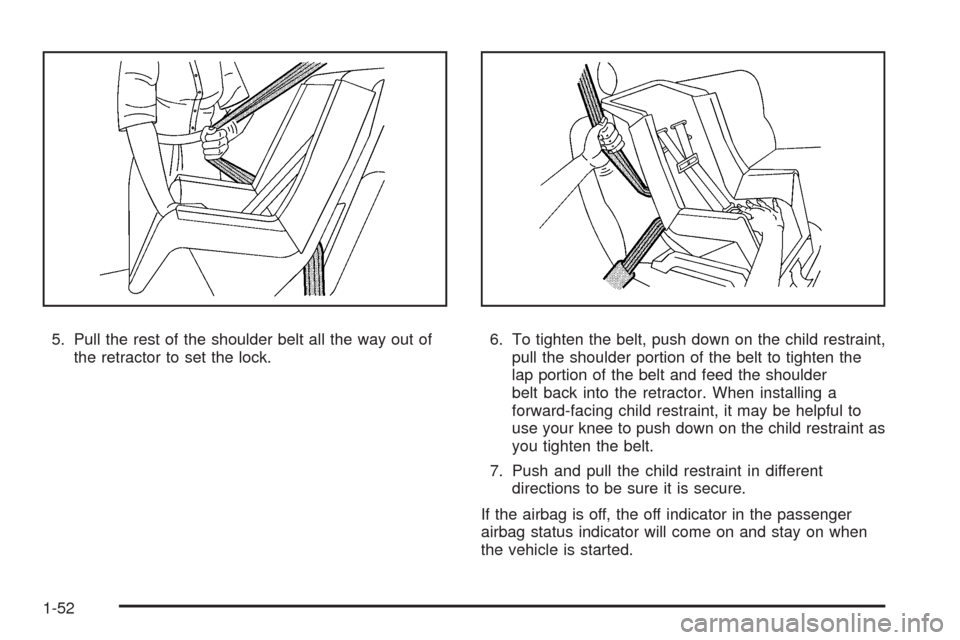CADILLAC ESCALADE EXT 2009 3.G Workshop Manual
Manufacturer: CADILLAC, Model Year: 2009, Model line: ESCALADE EXT, Model: CADILLAC ESCALADE EXT 2009 3.GPages: 546, PDF Size: 4.43 MB
Page 51 of 546

Notice:Do not let the LATCH attachments rub
against the vehicle’s safety belts. This may damage
these parts. If necessary, move buckled safety
belts to avoid rubbing the LATCH attachments.
Do not fold the empty rear seat with a safety belt
buckled. This could damage the safety belt or
the seat. Unbuckle and return the safety belt to its
stowed position, before folding the seat.
1. If the child restraint manufacturer recommends that
the top tether be attached, attach the top tether to the
top tether anchor, if there is one. Refer to the child
restraint instructions and the following steps:
1.1. To access the top tether anchors, raise the
seat cushion by pulling up on the strap loop
at the rear of the seat cushion and fold
the seat cushion forward. Then fold
the seatback forward until it is �at. SeeRear
Seat Operation on page 1-10for additional
information.
1.2. Place the child restraint in the vehicle, near
the seating position that you are using.1.3. Route the top tether according to your child
restraint instructions and the following
instructions:
If the position you are
using does not have a
headrest or head restraint
and you are using a
single tether, route the
tether over the seatback.
If the position you are
using does not have a
headrest or head restraint
and you are using a
dual tether, route the tether
over the seatback.
1-45
Page 52 of 546

If the position you are
using has an adjustable
headrest or head restraint
and you are using a
dual tether, route the tether
around the headrest or
head restraint.
If the position you are
using has an adjustable
headrest or head restraint
and you are using a
single tether, raise the
headrest or head restraint
and route the tether
under the headrest or head
restraint and in between
the headrest or head
restraint posts.
1.4. Attach the top tether attachment to the top
tether anchor.
{CAUTION:
If either seatback is not locked, it could move
forward in a sudden stop or crash. That could
cause injury to the person sitting there. Always
push and pull on the seatbacks to be sure they
are locked.
1.5. Lift the seatback up and push it rearward.
Then lower the seat cushion until the
seatback and the seat cushion lock into
position.
2. Attach the lower attachments to the lower anchors.
If the child restraint does not have lower
attachments or the desired seating position does
not have lower anchors, secure the child restraint
with the top tether and the safety belts. Refer
to your child restraint manufacturer instructions and
the instructions in this manual.
2.1. Find the lower anchors for the desired
seating position.
2.2. Put the child restraint on the seat.
2.3. Attach and tighten the lower attachments on
the child restraint to the lower anchors.
1-46
Page 53 of 546

3. Tighten the top tether.
4. Push and pull the child restraint in different
directions to be sure it is secure.
Securing a Child Restraint in a Rear
Seat Position
When securing a child restraint in a rear seating
position, study the instructions that came with the child
restraint to make sure it is compatible with this
vehicle.
If the child restraint has the LATCH system, seeLower
Anchors and Tethers for Children (LATCH) on
page 1-41for how and where to install the child restraint
using LATCH. If you secure a child restraint using a
safety belt and it uses a top tether, seeLower Anchors
and Tethers for Children (LATCH) on page 1-41for
top tether anchor locations.
Do not secure a child restraint in a position without a
top tether anchor if a national or local law requires that
the top tether be anchored, or if the instructions that
come with the child restraint say that the top strap must
be anchored.In Canada, the law requires that forward-facing child
restraints have a top tether, and that the tether be
attached.
If the child restraint does not have the LATCH system,
you will be using the safety belt to secure the child
restraint in this position. Be sure to follow the
instructions that came with the child restraint. Secure
the child in the child restraint when and as the
instructions say.
If more than one child restraint needs to be installed in
the rear seat, be sure to readWhere to Put the
Restraint on page 1-40.
If the child restraint manufacturer recommends using a
top tether, attach and tighten the top tether to the
top tether anchor. Refer to the instructions that came
with the child restraint and seeLower Anchors and
Tethers for Children (LATCH) on page 1-41.
1. Put the child restraint on the seat.
2. Pick up the latch plate, and run the lap and shoulder
portions of the vehicle’s safety belt through or
around the restraint. The child restraint instructions
will show you how.
1-47
Page 54 of 546

3. Push the latch plate into the buckle until it clicks.
Position the release button on the buckle so that
the safety belt could be quickly unbuckled if
necessary.4. Pull the rest of the shoulder belt all the way out of
the retractor to set the lock.
1-48
Page 55 of 546

5. To tighten the belt, push down on the child restraint,
pull the shoulder portion of the belt to tighten the
lap portion of the belt, and feed the shoulder
belt back into the retractor. When installing a
forward-facing child restraint, it may be helpful to
use your knee to push down on the child restraint as
you tighten the belt.
If the child restraint has a top tether, follow the child
restraint manufacturer’s instructions regarding the
use of the top tether. SeeLower Anchors and
Tethers for Children (LATCH) on page 1-41.
6. Push and pull the child restraint in different
directions to be sure it is secure.
To remove the child restraint, unbuckle the vehicle
safety belt and let it return to the stowed position.
If the top tether is attached to a top tether anchor,
disconnect it.
1-49
Page 56 of 546

Securing a Child Restraint in the
Right Front Seat Position
This vehicle has airbags. A rear seat is a safer place to
secure a forward-facing child restraint. SeeWhere to
Put the Restraint on page 1-40.
In addition, the vehicle has a passenger sensing system
which is designed to turn off the right front passenger
frontal airbag under certain conditions. SeePassenger
Sensing System on page 1-61andPassenger Airbag
Status Indicator on page 3-31for more information,
including important safety information.
A label on the sun visor says, “Never put a rear-facing
child seat in the front.” This is because the risk to
the rear-facing child is so great, if the airbag deploys.
{CAUTION:
A child in a rear-facing child restraint can be
seriously injured or killed if the right front
passenger airbag in�ates. This is because the
back of the rear-facing child restraint would be
very close to the in�ating airbag. A child in a
CAUTION: (Continued)
CAUTION: (Continued)
forward-facing child restraint can be seriously
injured or killed if the right front passenger airbag
in�ates and the passenger seat is in a forward
position.
Even if the passenger sensing system has turned
off the right front passenger frontal airbag, no
system is fail-safe. No one can guarantee that an
airbag will not deploy under some unusual
circumstance, even though it is turned off.
Secure rear-facing child restraints in a rear seat,
even if the airbag is off. If you secure a
forward-facing child restraint in the right front seat,
always move the front passenger seat as far back
as it will go. It is better to secure the child restraint
in a rear seat.
SeePassenger Sensing System on page 1-61for
additional information.
If the child restraint has the LATCH system, seeLower
Anchors and Tethers for Children (LATCH) on
page 1-41for how and where to install the child restraint
using LATCH. If a child restraint is secured using a
1-50
Page 57 of 546

safety belt and it uses a top tether, seeLower Anchors
and Tethers for Children (LATCH) on page 1-41for
top tether anchor locations.
Do not secure a child seat in a position without a top
tether anchor if a national or local law requires that the
top tether be anchored, or if the instructions that
come with the child restraint say that the top strap must
be anchored.
In Canada, the law requires that forward-facing child
restraints have a top tether, and that the tether be
attached.
You will be using the lap-shoulder belt to secure the
child restraint in this position. Follow the instructions that
came with the child restraint.
1. Move the seat as far back as it will go before
securing the forward-facing child restraint.
When the passenger sensing system has turned off
the right front passenger frontal airbag, the off
indicator on the passenger airbag status indicator
should light and stay lit when the vehicle is started.
SeePassenger Airbag Status Indicator on
page 3-31.
2. Put the child restraint on the seat.
3. Pick up the latch plate, and run the lap and shoulder
portions of the vehicle’s safety belt through or
around the restraint. The child restraint instructions
will show you how.4. Push the latch plate into the buckle until it clicks.
Position the release button on the buckle so that
the safety belt could be quickly unbuckled if
necessary.
1-51
Page 58 of 546

5. Pull the rest of the shoulder belt all the way out of
the retractor to set the lock.6. To tighten the belt, push down on the child restraint,
pull the shoulder portion of the belt to tighten the
lap portion of the belt and feed the shoulder
belt back into the retractor. When installing a
forward-facing child restraint, it may be helpful to
use your knee to push down on the child restraint as
you tighten the belt.
7. Push and pull the child restraint in different
directions to be sure it is secure.
If the airbag is off, the off indicator in the passenger
airbag status indicator will come on and stay on when
the vehicle is started.
1-52
Page 59 of 546

If a child restraint has been installed and the on
indicator is lit, see “If the On Indicator is Lit for a Child
Restraint ” underPassenger Sensing System on
page 1-61for more information.
To remove the child restraint, unbuckle the vehicle
safety belt and let it return to the stowed position.
Airbag System
The vehicle has the following airbags:
A frontal airbag for the driver.
A frontal airbag for the right front passenger.
A roof-rail airbag for the driver and passenger
directly behind the driver.
A roof-rail airbag for the right front passenger and
the person seated directly behind that passenger.All of the airbags in the vehicle will have the word
AIRBAG embossed in the trim or on an attached label
near the deployment opening.
For frontal airbags, the word AIRBAG will appear on the
middle part of the steering wheel for the driver and
on the instrument panel for the right front passenger.
With roof-rail airbags, the word AIRBAG will appear
along the headliner or trim.
Airbags are designed to supplement the protection
provided by safety belts. Even though today’s airbags
are also designed to help reduce the risk of injury
from the force of an in�ating bag, all airbags must in�ate
very quickly to do their job.
1-53
Page 60 of 546

Here are the most important things to know about the
airbag system:
{CAUTION:
You can be severely injured or killed in a crash if
you are not wearing your safety belt — even if you
have airbags. Airbags are designed to work with
safety belts, but do not replace them. Also,
airbags are not designed to deploy in every crash.
In some crashes safety belts are your only
restraint. SeeWhen Should an Airbag In�ate? on
page 1-58.
Wearing your safety belt during a crash helps
reduce your chance of hitting things inside the
vehicle or being ejected from it. Airbags are
“supplemental restraints” to the safety belts.
Everyone in your vehicle should wear a safety belt
properly — whether or not there is an airbag for
that person.
{CAUTION:
Airbags in�ate with great force, faster than the
blink of an eye. Anyone who is up against, or very
close to, any airbag when it in�ates can be
seriously injured or killed. Do not sit unnecessarily
close to the airbag, as you would be if you were
sitting on the edge of your seat or leaning forward.
Safety belts help keep you in position before and
during a crash. Always wear your safety belt, even
with airbags. The driver should sit as far back as
possible while still maintaining control of the
vehicle.
Occupants should not lean on or sleep against the
door or side windows in seating positions with
roof-rail airbags.
1-54